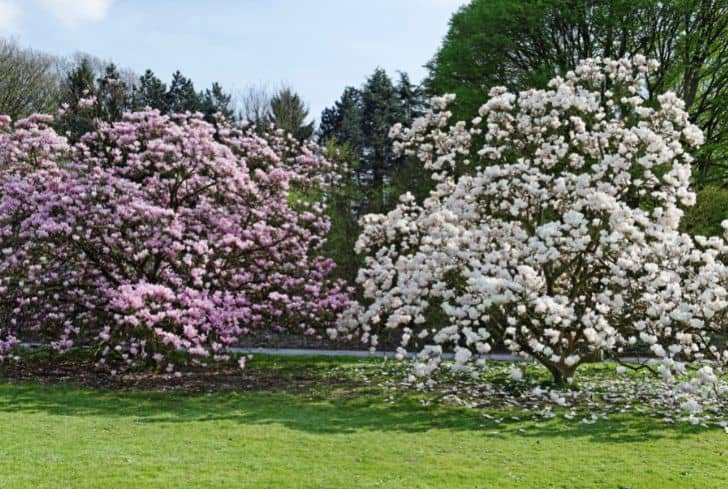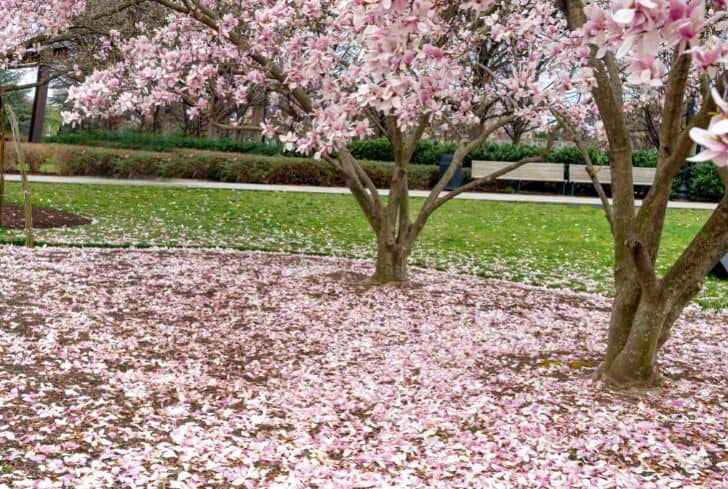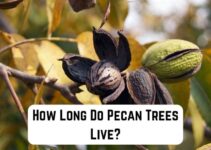Magnolia trees are coveted for their beautiful springtime flowers. These large pink and white blooms captivate homeowners and visitors from all over the United States. While the most popular magnolia tree is the southern magnolia, there are magnolia varieties that can grow in any zone in the contiguous United States!
How Fast Do Magnolia Trees Grow?
Since these trees are commonly added to landscape designs from north to south, many homeowners and landscaper novices wonder how fast magnolia trees grow.
Magnolia trees’ height and growth rate depend on which variety of magnolia you have and the conditions of the season. However, most magnolia tree varieties will grow between 1 to 2 feet per year until they reach maturity. For most magnolia varieties, the mature height of trees can range between 15 feet for shrubs and 80 feet for larger trees.
If you are hoping to add a magnolia tree to your landscape or yard but worry about space, there are many types of magnolia trees you can choose from. Some, like the lily and star magnolia, only reach about 15 feet in height at maturity. While others, like the famous southern magnolias, seem to touch the sky at 80 feet at maturity!
How Fast Do Different Magnolia Trees Grow?
With such wide varieties of magnolia trees, it is common to wonder which one is right for you. The first thing you need to consider is your USDA zone. These zones tell you which plants and trees thrive in your area’s climate.
Luckily, there are magnolia trees for every USDA zone in the United States. That means whether you live in Florida or Washington, or even Maine, you can enjoy a magnolia bursting with delicate flowers every spring.
Jane
Jane magnolia trees are best grown in zones 4 through 8. They will reach a mature height of 20 to 25 feet tall and have a spread that mimics their height. Jane magnolia trees are slow growing, usually adding less than 1 foot of height a year.
These magnolia trees will provide stunning reddish-purple blooms with a white interior from April to May each season. They prefer full sun but can handle part shade and require a medium amount of maintenance, usually requiring more pruning than other varieties.
Anne
Another beautiful magnolia option for zones 4 through 8 is the Anne magnolia. These magnolias present as shrubs and grow to a mature height of 10 to 12 feet. Since they don’t have a lot of height to achieve, they are also slow growing. Most Anne magnolia trees grow less than 1 foot a year.
They will, however, produce showy and fragrant purplish red flowers from April to May each spring. Like the Jane magnolia, the Anne magnolia also prefers full sun but will tolerate shade. The Anne Magnolia requires more pruning than other types of magnolia trees.
Bigleaf
Bigleaf magnolia is also called Japanese Bigleaf, white bark, or white leaf magnolia. These trees were native to Japan and the nearby Kirby Islands of Russia, making them ideal for USDA zones 5 through 7.
Larger than the Anne and Jane magnolias, the bigleaf tree will grow to about 25 to 40 feet in height and have a spread of 15 to 25 feet. Bigleaf magnolias will grow between 12 and 18 inches per year. They bloom fragrant creamy white flowers with red stamens in May and June and require little pruning.
Sweetbay
Native to the eastern United States, sweetbay magnolias can handle wet soil and air pollution. They produce showy and fragrant flowers from May to June that bloom with solid white petals.
These magnolia trees will grow between 12 and 24 inches a year, depending on outside factors. At maturity, they are between 10 and 35 feet tall with a spread that mimics their height. Because of their native habitat, they thrive best in zones 5 to 10 and are generally low maintenance.

Anise
Anise magnolias are native to Japan and are best grown in zones 6-9. These magnolias offer beautiful white blooms on naked branches as they bloom before the leaves of the tree unfurl in the spring. These trees will reach a mature height between 30 and 50 feet with a spread to match. They are relatively quick growing for magnolia and will grow about 24 inches per year in the right conditions.
Star
The red, pink, yellow, white, and purple flowers that grow on star magnolias truly make this variety a star in its own right. This magnolia is a slow-growing variety. Eventually, the tree will reach its mature size between 15 to 20 feet tall and about 15 feet wide.
It grows best in the USDA zones 4-9 and is native to Asia. The small stature and easy-to-care-for attitude make the star magnolia tree a common choice for homeowners and landscapers.
Saucer
The saucer magnolia is known for its stunning and bold white shaded with deep pink to pinkish purple flowers that bloom every spring. The flowers are fragrant and are usually one of the first to be seen each season. The saucer magnolia thrives in zones 4-9.
It grows between 20 to 30 feet high and has an average spread of 25 feet. Saucer magnolias tend to grow quickly compared to other magnolia varieties. They prefer moist, deep, and acidic soil. These trees also do best in full sun.
Southern
Perhaps the most famous magnolia variety is the southern magnolia. These trees are large and stately, oftentimes growing to 60 to 80 feet in height with a 40 foot spread. These trees are evergreen, meaning they keep most of their leaves even in the winter.
However, they will only do well in zones 6-10. Southern magnolias are medium to fast-growing, usually adding 12-24 inches to their height a year. These trees produce large, creamy white flowers in late spring into early summer. The flowers are extremely fragrant and highly sought after.
Little Gem
If you want the drama and grace of a southern magnolia without the size, a little gem magnolia may be right for you. This hybrid is a much smaller version of the southern magnolia but will grow to a mature size between 15 and 20 feet tall with a 7-foot spread.
These evergreen shrubs are often used in landscaping or to create privacy hedges. The little gem magnolia blooms with the same types of flowers as the southern magnolia, a fragrant and creamy white bloom. They are slow growing and will not grow more than 12 inches in one year.
Lily
Another small and slow-growing magnolia is the lily magnolia. Originating in Asia, this tree grows less than 12 inches a year and will reach a mature height between 8 and 12 feet tall. These magnolias are another common choice for landscape and hedge trees. They produce pink and purple flowers in springtime, often before their leaves have unfurled. These magnolias thrive in zones 5-8.
Kobus
Also growing in zones 5-8 is the Kobus magnolia. This tree produces beautiful perfumed white flowers once established. Sadly, the tree can take about 25 years to become mature enough to produce consistent and showy flowers.
They mature to a size of 25 to 30 feet tall. They will grow between 12 and 24 inches each year until they reach their mature size. Kobus magnolia trees like full sun and well-draining soil.
Where Do Magnolia Trees Grow Best?
Magnolia trees are native to many places throughout Asia and the United States. Due to their many different native habitats, these trees have adapted to many new environments.
Thanks to their versatility, there are now magnolia trees that have adapted to live in every part of the contiguous United States.
Depending on which USDA hardiness zone you live in, your options for a magnolia tree may be limited. Many magnolia trees will do well in zones 4-8. Other zones may have too harsh of winter or become too hot in the summer. However, magnolia trees are resilient and have been known to grow in places and conditions that are less than ideal.
Do Magnolia Trees Need a Lot of Water?
Magnolia trees are generally easy to care for and low maintenance. Even so, every living thing needs water to survive and thrive.
Magnolia trees do not require a lot of water to grow. However, conditions such as temperature, drought, and climate will all have an effect on how much water a particular magnolia tree needs.
Trees that grow in hotter climates will need more water than those that grow in cooler climates. Also, younger trees that are growing and producing new limbs and leaves will need more water than a mature tree that has stopped growing taller.
Can You Keep a Magnolia Tree Small?
Magnolia trees are often selected for their stunning springtime flowers and unique foliage. They also come in a variety of shapes and sizes, making it easy to see why they are so often included in landscape designs.
While you can keep a magnolia smaller by pruning it back, it is not advised to remove too much of the tree, or you risk damaging it.
Be sure to choose a magnolia tree variety that has a smaller mature size. Some, like kobus, lily, and little gem magnolias, will not exceed 20 feet in height. These varieties also tend to have a smaller spread than larger magnolia trees.
Keeping your tree trimmed and pruned back will help slow the growth. However, be aware that removing too much of the tree can seriously hinder and even kill it.
Related Questions
How Can I Make My Magnolia Tree Grow Faster?
To help your magnolia tree grow quicker in the summer months, spread mulch around the base to cover the roots. This will keep the area moist and protected from the sun, allowing the tree to grow more quickly.
What Is The Lifespan of a Magnolia Tree?
The southern magnolia tree will live between 80-120 years.
Conclusion
Magnolia trees offer stunning springtime displays and have unique foliage. These trees come in a variety of shapes and sizes, ranging from 8 feet to 80 feet in height.
All magnolia trees bloom with flowers in the early spring to late summer, making them a common choice for landscapes.
Choosing the right magnolia tree for you will depend on where you live, how large of the tree you want, and where you want to grow it.






